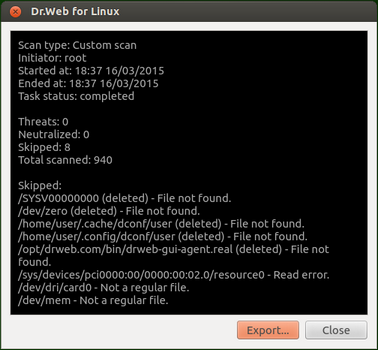You can view the list of created tasks and tasks in progress on the special Dr.Web for Linux page. If at least one task is queued, a button that opens the page with the task list becomes visible on the navigation pane. Depending on the status of the queued tasks, the button has one of the following icons:
|
At least one of the tasks is not complete (icon is animated). |
|
All scanning tasks in the list are complete or stopped by the user; no threat is detected or all detected threats are successfully neutralized. |
|
All scanning tasks in the list are complete or stopped by the user; some of the detected threats are not neutralized. |
|
All scanning tasks in the list are complete or stopped by the user. Some of the tasks failed. |
Tasks are sorted by date (from the first created task to the most recent).

Picture 29. Task management page
For each listed task, the following information is available:
•Scan type (Express scan, Complete scan, and Custom scan, or other types of scanning; for details, see below);
•Name of the user who started scanning (if unknown, the system UID is displayed);
•Date of task creation and completion (if complete);
•Number of detected threats, neutralized threats, skipped files, and total number of scanned objects.
The status of the task is indicated with the colour mark assigned to the listed task. The following colors are used:
|
– Scanning is not complete or is pending. |
|
|
– Scanning is complete or stopped by the user; no threat is detected or all detected threats are neutralized. |
|
|
– Scanning is stopped due to an error. |
|
|
– Scanning is complete or stopped by the user; at least one detected threat is not neutralized. |
Note that the list contains scanning tasks performed by Scanner in the current session, not just the tasks created by the user in graphics mode. Other types of scanning can be the following:
•Console scanning – scanning initiated by the user or an external application via the command-line interface;
•Centralized scanning – scanning initiated by the central protection server;
•Scheduled scanning – scanning started automatically according to the specified schedule.
On the task description area, one of the following buttons is available:
oCancel – cancel the pending task. The button is available if the task is pending. Once the button is clicked, the task completes. Information on the task remains in the list.
oStop – stop the task which is in progress. After you click this button, the stopped task cannot be resumed. The button is available if the task is in progress. Information on the stopped task remains in the list.
oClose – close information on the complete task and delete the task from the list. The button is available if the task is not complete and if all detected threats are neutralized.
oNeutralize – neutralize threats. The button is available if the task is complete and some of the detected threats are not neutralized.
oDetails – open the list with detected threats and neutralize them. The button is available if the task is complete and some of the detected threats are not neutralized.
Click Scan log to display information on scanning results including detailed information on the task and the list of detected threats, if any.

Picture 30. Detailed information on scanning results
Note: File systems of UNIX-like OS, such as Linux, can contain special objects that appear as named files but are not actual files containing data (for example, such objects are symbolic links, sockets, named pipes, and device files). They are called special files as opposed to usual (regular) ones. Dr.Web for Linux always skips special files during scanning.
Click Export to save information on the scanning process to the text file. Click the name of a detected threat to open a webpage with information on the threat in your browser (a threat name is a link to the official Doctor Web website; a valid Internet connection is required).
To any threat detected during scanning which was started in graphics mode (including a scheduled scanning), Dr.Web for Linux applies actions that are specified in the settings on the Scanner tab.
|
Note that threat neutralization settings specified on the Scanner tab are not used for centralized and console scanning. |
To view all detected threats, open the page with listed detected threats.